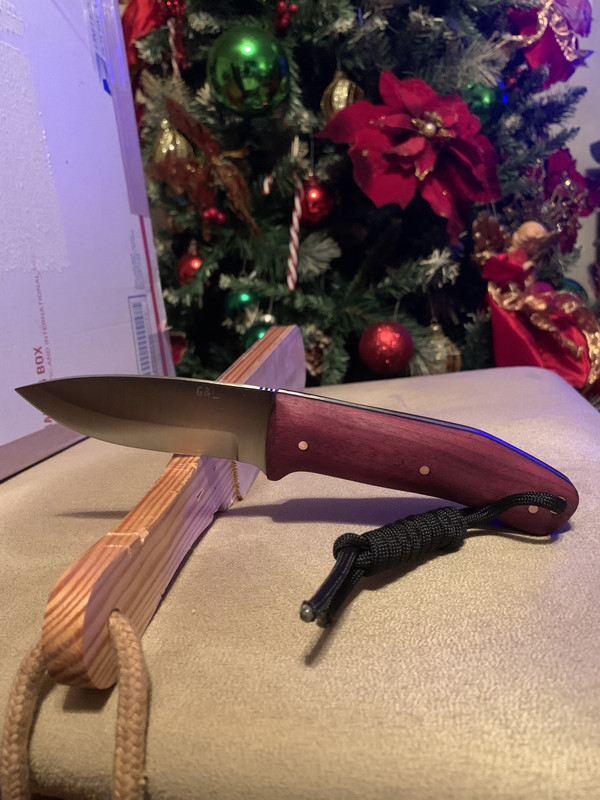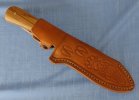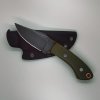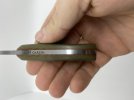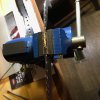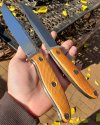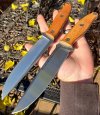-
The BladeForums.com 2024 Traditional Knife is ready to order! See this thread for details: https://www.bladeforums.com/threads/bladeforums-2024-traditional-knife.2003187/
Price is$300$250 ea (shipped within CONUS). If you live outside the US, I will contact you after your order for extra shipping charges.
Order here: https://www.bladeforums.com/help/2024-traditional/ - Order as many as you like, we have plenty.
You are using an out of date browser. It may not display this or other websites correctly.
You should upgrade or use an alternative browser.
You should upgrade or use an alternative browser.
What's going on in your shop? Show us whats going on, and talk a bit about your work!
- Thread starter WillSwift
- Start date
- Joined
- Jun 3, 2019
- Messages
- 2,714
Scaniaman - beautiful knives, specially the handles. Did you make those mosaic pins?
question - actually serious: if the Petty is the japanese equivalent of a western Utility knife, but at least started with a Wa handle ... why not call these blades Utility knives?
question - actually serious: if the Petty is the japanese equivalent of a western Utility knife, but at least started with a Wa handle ... why not call these blades Utility knives?
- Joined
- Apr 13, 2017
- Messages
- 2,124
Cliff Carter Knives
Knifemaker / Craftsman / Service Provider
- Joined
- May 30, 2011
- Messages
- 749
Thank you, I actuall think I enjoy making handles more than blades sometimes 
No I bought the pins ready made. Red one from GFS, the other I can't remember.
I see your point on the nomenclature, it is valid. I was looking a little at japanese blades, when I gave the tip its shape and I think that's why. But it's an interesting discussion. When does a "chef knife" become a "gyuto"? Does it have to have a Wa handle? Or is it more in the blade profile? I guess a Nakiri, which is pretty easy and obvious to identify in regard to its blade profile, is a Nakiri regardless if it has a Wa or a full tang western looking handle?
Also, japanese style blades trend, so I think makers would rather use japanese terms and styles in many cases. Just the other day I came across this typical western chef knife on IG, that was referred to as as gyuto by the (rather well known) maker...I couldn't identify anything japanese in there at all.
I am no expert at all on these topics, so please fill in.
Me personally, I love well sculpted western handles with comfortable palm swells, and japanese blade profiles. I think the mix is where I want to go in my designs.
No I bought the pins ready made. Red one from GFS, the other I can't remember.
I see your point on the nomenclature, it is valid. I was looking a little at japanese blades, when I gave the tip its shape and I think that's why. But it's an interesting discussion. When does a "chef knife" become a "gyuto"? Does it have to have a Wa handle? Or is it more in the blade profile? I guess a Nakiri, which is pretty easy and obvious to identify in regard to its blade profile, is a Nakiri regardless if it has a Wa or a full tang western looking handle?
Also, japanese style blades trend, so I think makers would rather use japanese terms and styles in many cases. Just the other day I came across this typical western chef knife on IG, that was referred to as as gyuto by the (rather well known) maker...I couldn't identify anything japanese in there at all.
I am no expert at all on these topics, so please fill in.
Me personally, I love well sculpted western handles with comfortable palm swells, and japanese blade profiles. I think the mix is where I want to go in my designs.
Scaniaman - beautiful knives, specially the handles. Did you make those mosaic pins?
question - actually serious: if the Petty is the japanese equivalent of a western Utility knife, but at least started with a Wa handle ... why not call these blades Utility knives?
- Joined
- Jan 11, 2019
- Messages
- 1,484
Thank you, I actuall think I enjoy making handles more than blades sometimes
No I bought the pins ready made. Red one from GFS, the other I can't remember.
I see your point on the nomenclature, it is valid. I was looking a little at japanese blades, when I gave the tip its shape and I think that's why. But it's an interesting discussion. When does a "chef knife" become a "gyuto"? Does it have to have a Wa handle? Or is it more in the blade profile? I guess a Nakiri, which is pretty easy and obvious to identify in regard to its blade profile, is a Nakiri regardless if it has a Wa or a full tang western looking handle?
Also, japanese style blades trend, so I think makers would rather use japanese terms and styles in many cases. Just the other day I came across this typical western chef knife on IG, that was referred to as as gyuto by the (rather well known) maker...I couldn't identify anything japanese in there at all.
I am no expert at all on these topics, so please fill in.
Me personally, I love well sculpted western handles with comfortable palm swells, and japanese blade profiles. I think the mix is where I want to go in my designs.
It seems that is one of these things there is a collective understanding of among the (kitchen) knife crowd. And then there are others, purists, traditional or whatever (like primary/secondary bevel kind of story). My understandig is the Japanese profiles have Japanese names and then the handle is described as western style or WA. If you want to be correct or describe fully, you would describe grind style, technique, steel and dimensions. This is also how the selling sites for the Japanese knifes do it. To me in it makes sense.
So I would also call your petty a petty, due to the distinct petty profile with dropped tips. The rest I already know (BTW what stock thickness do you use for this?) , but to a customer or selling add you would probably add the rest.
It seems that is one of these things there is a collective understanding of among the (kitchen) knife crowd. And then there are others, purists, traditional or whatever (like primary/secondary bevel kind of story). My understandig is the Japanese profiles have Japanese names and then the handle is described as western style or WA. If you want to be correct or describe fully, you would describe grind style, technique, steel and dimensions. This is also how the selling sites for the Japanese knifes do it. To me in it makes sense.
So I would also call your petty a petty, due to the distinct petty profile with dropped tips. The rest I already know (BTW what stock thickness do you use for this?) , but to a customer or selling add you would probably add the rest.
Ok, makes sense.
I use 2mm thick 14c28n for these knives. I have made them in 2.5 mm as well and that works too but hiding the plunge is easier on thinner stock with this blade height.
- Joined
- Jun 3, 2019
- Messages
- 2,714
So I guess I am looking at different things than you two are. Almost all of the example pettys (and gyotus for that matter) actually have a very close to symmetrical blade profile at the tip. The drop point is more a feature of a Kiritsuke ... so at least in my mind, the drop point does not make it a petty....
also, again all of the examples I have seen for pettys, gyotus, and santokus have a very distinct ricasso, perhaps 0.5 inch or more, between the front of the handle and the drop down to the blade ... but confusingly, when the japanese makers market a “western style petty “ ( and they still call it a petty) they lose that pronounced ricasso
I don’t know ... maybe the discussion is a fools errand, because what a blade is called has become so much tied up in marketing double-speak. Maybe the only thing to rest on is that the steel tends to be thinner, and the blades tend to be ground to a smaller tbe... but those are difficult to see at first glance...
also, again all of the examples I have seen for pettys, gyotus, and santokus have a very distinct ricasso, perhaps 0.5 inch or more, between the front of the handle and the drop down to the blade ... but confusingly, when the japanese makers market a “western style petty “ ( and they still call it a petty) they lose that pronounced ricasso
I don’t know ... maybe the discussion is a fools errand, because what a blade is called has become so much tied up in marketing double-speak. Maybe the only thing to rest on is that the steel tends to be thinner, and the blades tend to be ground to a smaller tbe... but those are difficult to see at first glance...
- Joined
- Jun 3, 2019
- Messages
- 2,714
The other thing to perhaps keep in mind here is that the gyotu and petty actually are NOT traditional japanese knives (like the Nakiri, deba, and yanagiba are for example). They are recent additions by the japanese makers specifically intended to compete with the western chefs and utility knives (and which is why they look so similar to their western counterparts, and the differences are really blurred).
me ... I stick with wa handles and a long ricasso ... and there is no confusion.
after all - at least to my knowledge, I have not so far seen any European company trying to market a Wa-utility knife.
me ... I stick with wa handles and a long ricasso ... and there is no confusion.
after all - at least to my knowledge, I have not so far seen any European company trying to market a Wa-utility knife.
- Joined
- Jan 11, 2019
- Messages
- 1,484
(As a buyer and hobby maker) I don't think the name is important at all, give me good pics, steel type, hardness and dimensions and I will know more then if you describe it as a petty or utility.
Of course for marketing and selling purposes to a full time blademaker or a business it will make a difference if they describe it differently, especially since people will tend to think it's better because it's Japanese or German or called fancy names. I think most chefs, knife conoscuers and steel nerds won't care what you call it, but how it looks and performs.
Of course for marketing and selling purposes to a full time blademaker or a business it will make a difference if they describe it differently, especially since people will tend to think it's better because it's Japanese or German or called fancy names. I think most chefs, knife conoscuers and steel nerds won't care what you call it, but how it looks and performs.
bike4fun919 OpbunchKnives
Knifemaker / Craftsman / Service Provider
- Joined
- May 5, 2014
- Messages
- 961
- Joined
- Dec 1, 2015
- Messages
- 8
After years lurking around here and the last 2 years without a shop I finally got my shop setup and made a knife I'm not to embarrassed to show here. 1095 brass liners nickel silver bolsters and jigged bone. hopefully I learned how to post the pics correctly.
Well guess I failed on the pics


Well guess I failed on the pics
Last edited:
- Joined
- Jul 2, 2018
- Messages
- 403

Interesting billet I got from a good dude on Instagram. I have some cool ironwood burl scales going on today.
- Joined
- Jul 2, 2018
- Messages
- 403

Put some ironwood handles on today.
DanF
Knifemaker / Craftsman / Service Provider
- Joined
- Apr 17, 2017
- Messages
- 1,485

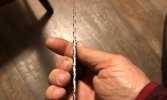 Six large hunters in the works, in 15N20. I’ve had a request for some time for this style knife with file work, so I pulled one out of the batch and started the initial work to define it.
Six large hunters in the works, in 15N20. I’ve had a request for some time for this style knife with file work, so I pulled one out of the batch and started the initial work to define it.First image is the layout cuts, second is the start of the definition.
Closer to the tip will be completed after grinding to preserved the figure.
Long, tiring way to go.
I typically only do this on select slippies as fixed-blade knives have a LOT of real estate (translated to many manhours labor).



